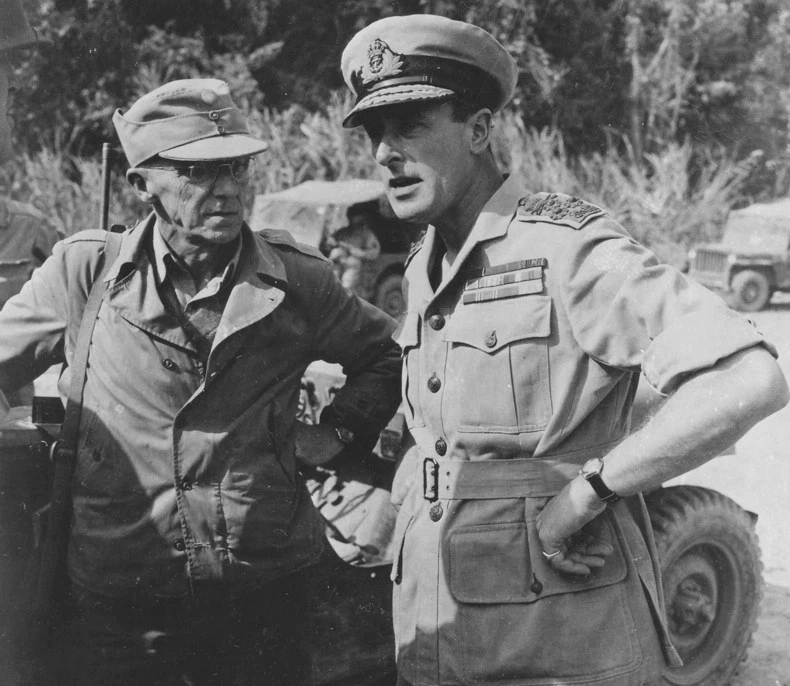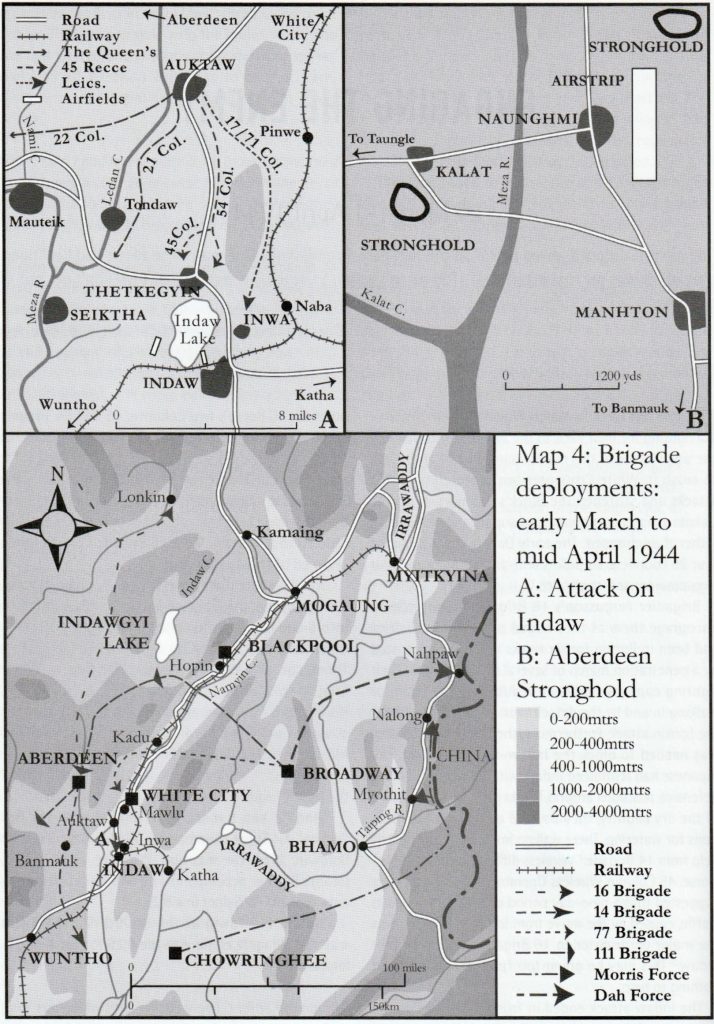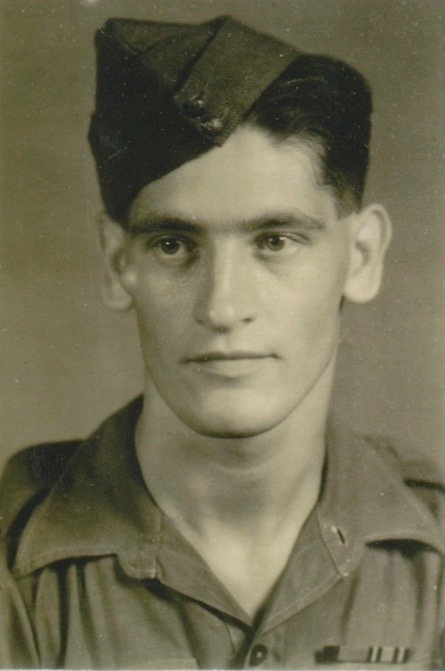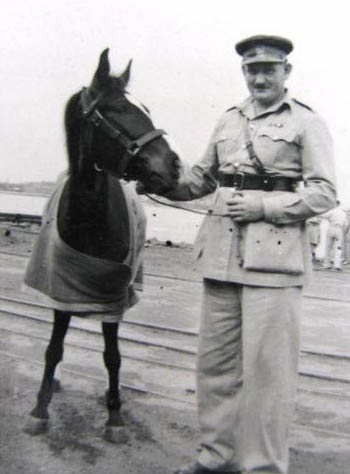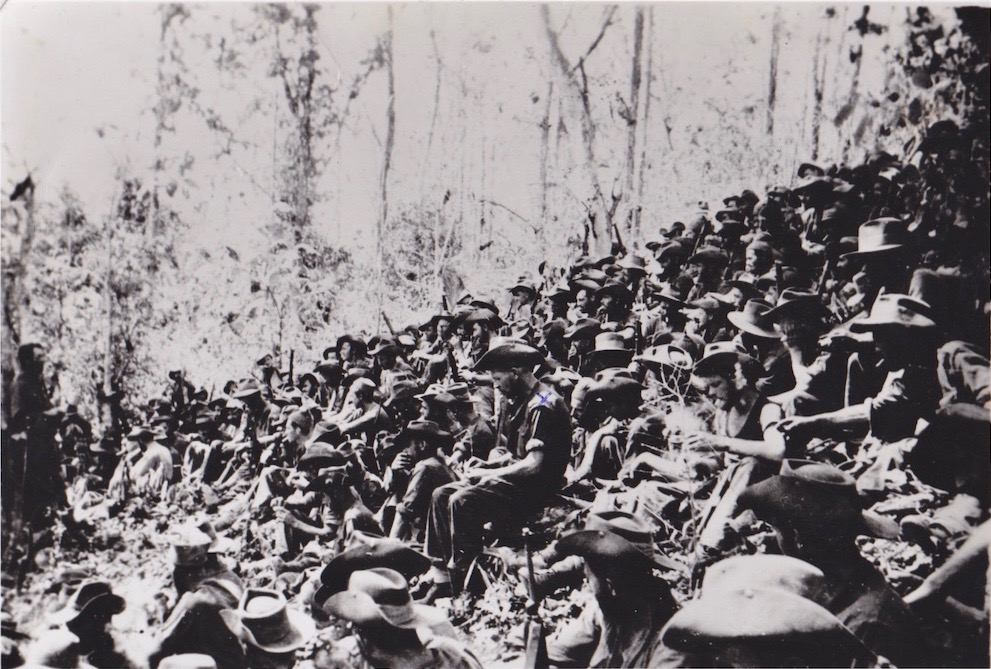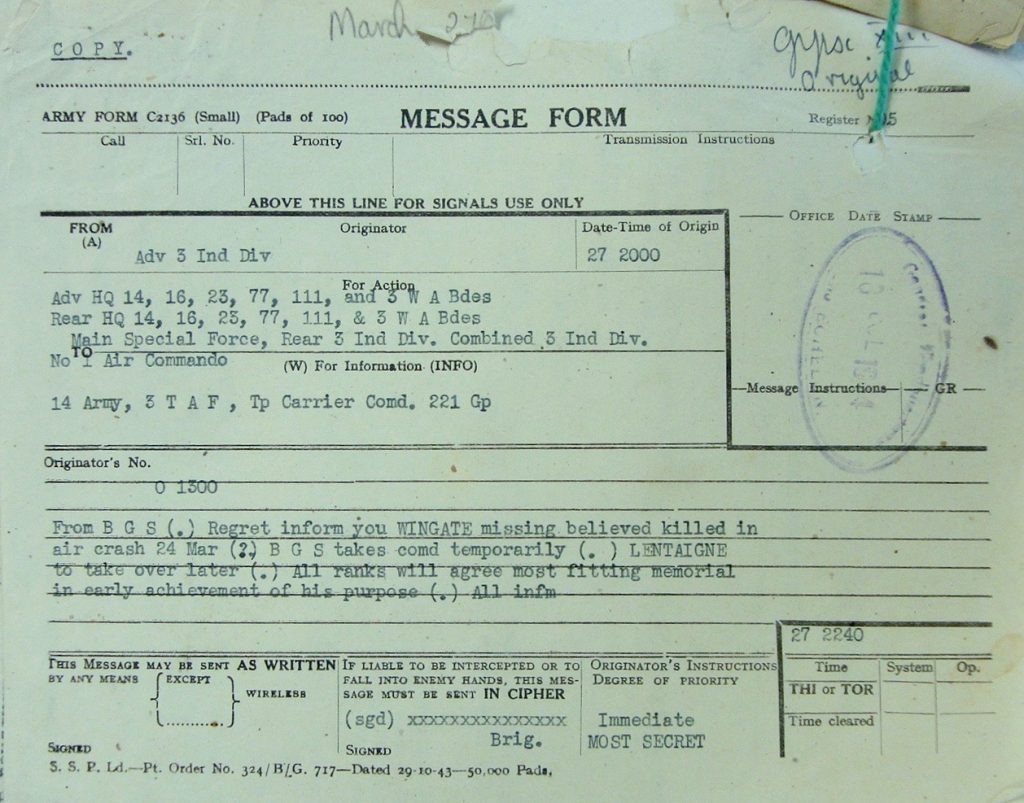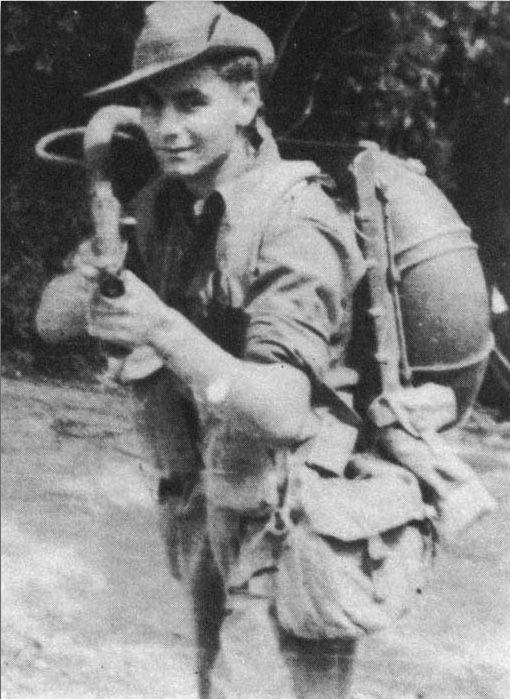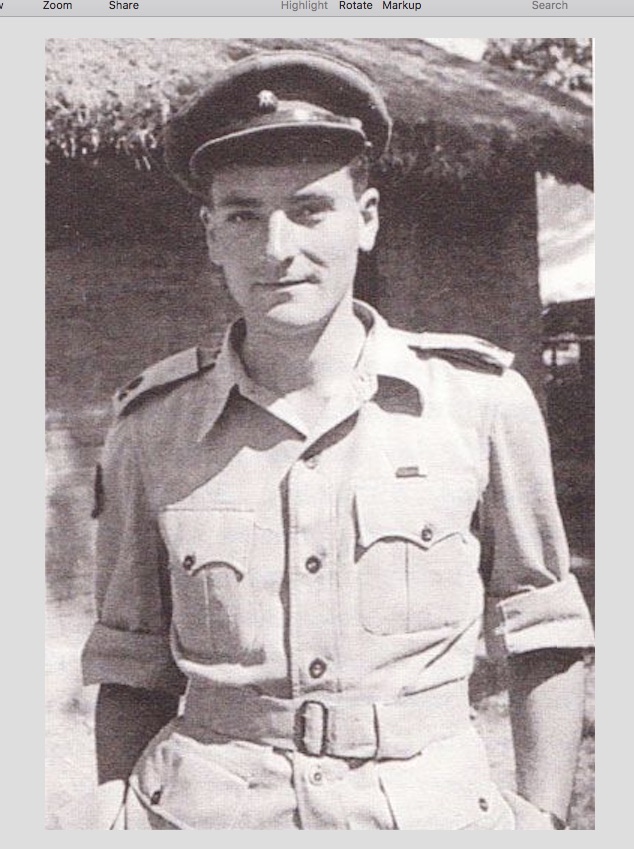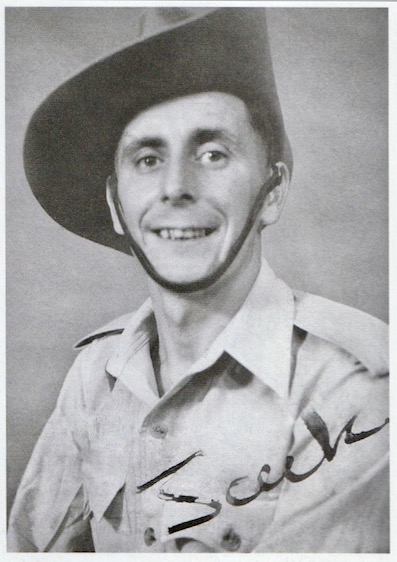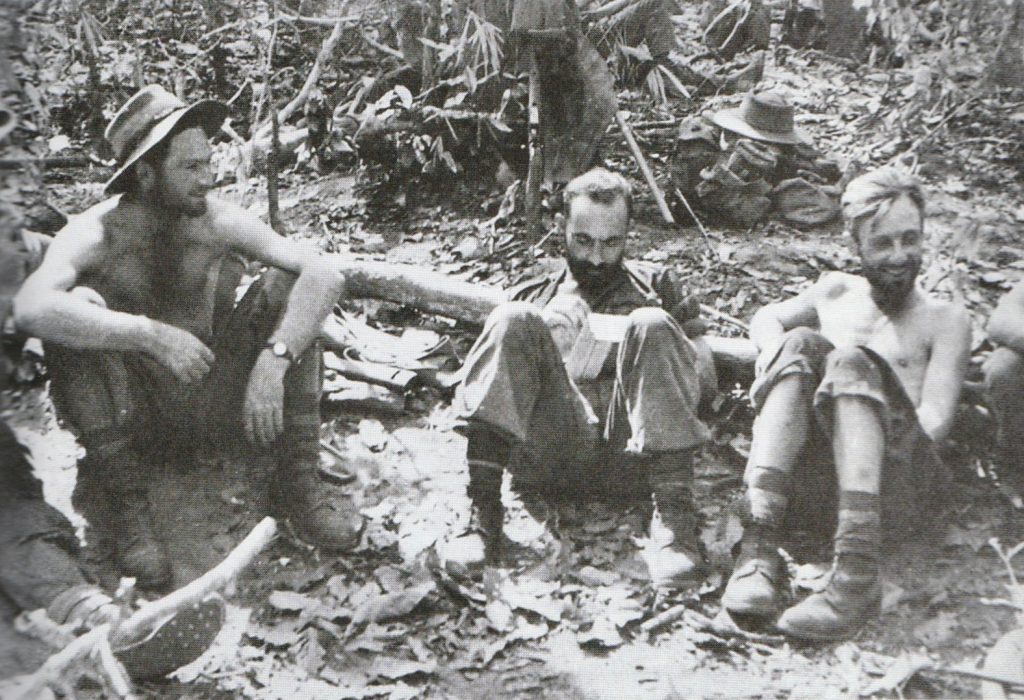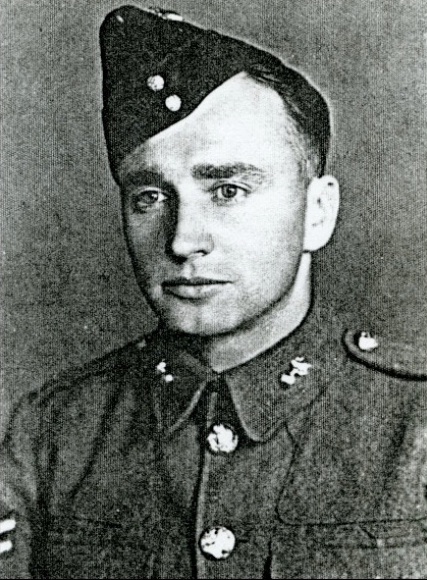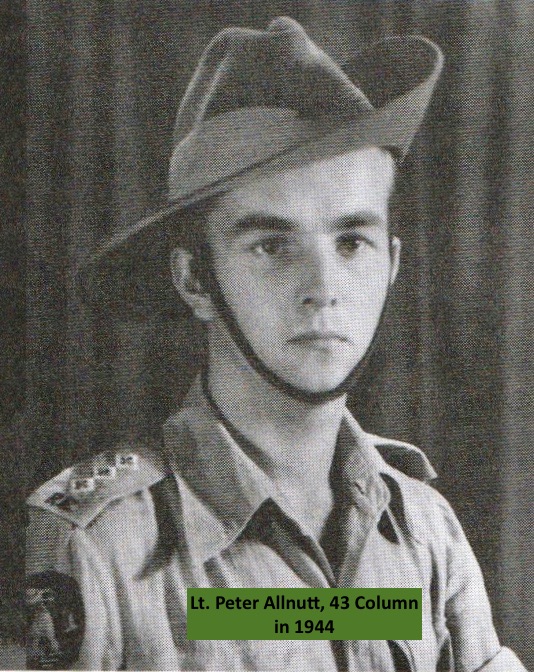REMEMBERING OPERATION THURSDAY 75 YEARS ON
The Japanese were determined to crush the Chindits and remove the threat to the supply lines serving their divisions fighting in North Burma. White City, the “Block” on the south-north railway and road, continued to hold out despite fanatical attacks against its wired defences. The Chindits’ main “Stronghold” base, Broadway, came under air attack and a ground assault was in prospect. The task of destroying “Special Force” had been given to the Indaw-based, newly formed Anti-Airborne Forces Brigade. From now on, every Chindit would have to fight for his life.
—ooo—
Orde Wingate was reluctant to place his eggs in one basket: the Chindits needed another Stronghold. At first light on March 22 six gliders landed in a jungle clearing named “Aberdeen”. An American engineering team began to prepare a C-47 strip. During the early evening of the next day lead elements of Brigadier Brodie’s 14 Brigade began to arrive. They were to block the Indaw-Banmauk road and seal the southern approaches to Indaw and White City. Meanwhile, 111 Brigade’s columns were ordered to stop Japanese movements along the Pinlebu-Pinbon road, while 16 Brigade, led by Bernard Fergusson, was to attack the main garrison town, Indaw.
After an appalling final leg of their terrible march into Burma, with progress reduced at some points to 100 yards per hour, 16 Brigade elements finally reached Aberdeen clearing, some 60 miles west of Broadway Stronghold. The Aberdeen clearing was at Manhton, just east of the Meza River and 25 miles from the railway supplying the Japanese 18th Division, fighting Stilwell’s Chinese troops, and the 56th Division, opposing the Yunnan Chinese.
Aberdeen took in three villages: Manhton, Kalat and Naunghmi. Aberdeen’s site had a lot of advantages. It was only two days’ march from Indaw and 14 miles from the Indaw-Banmauk road. The dominant feature was a hill at the northern end, where the permanent garrison would be quartered. There were, however, some drawbacks – mainly the fact that, as Fergusson himself acknowledged, it was “highly accessible” to the enemy.
The airstrip was available by the evening of March 23. Some 700 sorties were flown into Aberdeen in the six weeks to its closure in the first half of May 1944. Many of Fergusson’s men were desperate for the rations available at Aberdeen. On March 19 45 Column took a drop near Mezan village and left half the supplies cached for sister Column 54, bringing up the rear of 16 Brigade. Wireless Operator Philip Sharpe wrote: “It was at this drop that a Lance Corporal and three men were caught stealing rations and charged. Certainly, they were not the only party on collection who had done this but, according to the grapevine, they had been suspected previously. Before we moved off they were flogged by the CSM in front of their platoon and the Lance Corporal was reduced to the ranks.”
Floggings were rare but did occur from time to time for serious offences, such as sleeping on sentry duty or stealing rations.
The Queen’s Columns, 21 and 22, arrived at Aberdeen on 19 March. They soon moved off, to support the main 16 Brigade assault on Indaw. They were also expected to ambush the Indaw-Banmauk road at Milestone 20. Wingate had issued fresh orders on March 12, requiring the Leicester’s and 45 Recce to attack Indaw from the north. Originally, they were to orbit Indaw and attack from a south-easterly direction. Now it would be a frontal assault.
The 16 Brigade Chindits had been on the ground, working at maximum capacity on poor and occasionally non-existent rations for some weeks. Now the men were paying the price. Shortly after leaving Aberdeen, 21 Column Wireless Operator George Hill went down with dysentery: “This is one of the most debilitating afflictions. It is absolutely essential to ‘answer the call’ immediately, since there is very little warning of, and even less control over, the impending discharge of very hot, virtually liquid matter – which can be, and usually is, a very painful experience! In the early stages of the problem I once didn’t make it in time and spent that night operating the wireless set standing up, a distinctly awkward procedure. I carried the results of that episode around with me until we arrived back at Aberdeen some three weeks later, the first opportunity I had to do anything about it.”
When on the march, Chindits with dysentery and falling out of the Column to relieve themselves found it increasingly difficult to regain their places. Later, in extremis, some sufferers gave up the struggle and cut holes in the seat of their pants, to make the whole process as straightforward as possible.
Some Chindit Columns had yet to fly in. They went through the usual Chindit ritual at Lalaghat airfield, when grouped into plane-loads. Each man had to decide what was vital to carry in. Everyone went through his kit, which might include toggle rope, mae west, cardigan, gym shoes, spare shirts, shorts, socks, pants, groundsheet, blanket, mess tin, knife, fork and spoon, towel, soap, machete or Dah, spare laces, mosquito cream, Mepacrine, sharp knife, two grenades, chagul, five days’ rations, weapons and ammunition. Philip Graves-Morris, 14 Brigade Commander, wrote: “Experiments in personal loads had been made throughout training but, when packing up for the last time, everything seemed so important that one felt that one should leave nothing behind.”
Lead elements of the York and Lancaster columns of 14 Brigade took off from Lalaghat on April 1, but torrential rain made the strip unserviceable and the aircraft had to turn back. They made successful landings the following day. The fly-in of the York and Lancaster Columns, 65 and 84, was slowed by bad weather but was completed on April 4. Then Aberdeen’s main garrison, the Nigerians of 39 and 66 Columns, flew in over the following week. The base was closed just over three weeks later, on May 6. It was never attacked by Japanese ground forces, but there were numerous air raids.
Things were different at White City. Its defenders continued to repulse repeated Japanese attacks. Private John Hutchin: “We were doing well. I didn’t think we would hold the Japanese that long, but we took a lot of punishment, with many killed and wounded. One man died in my trench. Shrapnel cut his stomach open.
“The supply situation at White City was excellent. Our defences were now very heavily wired and we withstood repeated assaults. Besides the wire, the airdrops included lime, as the stench of dead men and mules became overwhelming in the heat. The Japs tried to blow gaps in the wire using Bangalore Torpedoes – long lengths of bamboo filled with explosives.”
White City’s defences survived a severe test on the night of March 21, in a savage attack lasting eight hours. The Japanese made their only penetration of the wire but were soon ejected. They lost 300 killed. The Chindits also suffered losses. Lancashire Fusiliers’ Regimental Signaller Ian Niven, with 20 Column, remembers Fusilier Leo Conroy, killed at White City at the time. Niven himself had a close call: “We were being shelled by a heavy mortar. There was a tremendous explosion near me. The blast hit me from the left and I was blown into the trench. Then someone else jumped in and landed with their legs over my shoulders. I knew we were safe in that hole but the back of my neck was wet. I thought he’d been wounded. In fact, he’d pissed himself as he jumped into the trench. I was just happy he wasn’t wounded.”
Wingate visited Bernard Fergusson at Aberdeen. Fergusson wanted to rest 16 Brigade after its exhausting march in but Wingate told him to press on to Indaw before it could be reinforced. Unfortunately, however, the Japanese had already accomplished this. The Indaw attack plan was confirmed during the night of March 24. The 2nd Leicester’s and 45 Recce would attack Indaw from the east and north respectively. One Column of the Queen’s would block the Banmauk-Indaw road and the other would attack on the west. The Leicester’s would take Inwa village, one mile north of Indaw and 45 Recce would occupy the north end of Indaw Lake.
At this time there was no real appreciation of the scale of the Japanese response to Operation Thursday. Around 20,000 Japanese troops were massing in the main Chindit operational area of Indaw-Mawlu. Later, Calvert reflected: “The 14th Army, fighting for its life on long land lines of communication, but now supplied and reinforced from the air, also never appreciated that the Chindits eventually absorbed the strength of two Japanese Divisions while they themselves had only three and a half Divisions to counter.”
Fergusson’s weary men left Aberdeen on March 24. Two of their Columns, 51 and 69, had been detached to attack Lonkin village and were still 10 days behind them and, therefore, too late to contribute to the Indaw attack. In fact, it took them until April 10 to reach Aberdeen.
The 2nd Leicester’s led 16 Brigade’s advance on Indaw. Fergusson’s planning assumed the attack would be supported by 14 Brigade but he was to be disappointed. Wingate, on his part, hoped that capture of Indaw’s airfields would prompt the fly-in of additional forces (although he had already been warned to the contrary). In reality, the Indaw venture was already doomed, due to the sheer scale of the Japanese reinforcement of its garrison.
They marched through dry country, with all water sources covered by the Japanese. The Chindits would have to fight for their water. Lieutenant Colonel Graves-Morris, Commander of 14 Brigade’s York and Lancaster Columns, wrote: “Water had to be reached at least once every day … it was estimated by the medical staff that the men should drink at least 12 pints a day to replace the loss of sweat. Except when near good streams, of course, this was seldom possible.”
In the White City perimeter, men took solace from the companionship of the animals sharing their hardships. A pony gave birth to a foal during a Japanese attack and murderous mortar barrage. The foal was named “Minnie” after a nearby mortar post. In another attack, Minnie was kicked in the eye by a panic-stricken mule. They fought to save the eye and 77 Brigade Commander Mike Calvert ordered regular reports of Minnie’s progress to be circulated to all forward positions. When recovered, Minnie took to “doing the rounds” of the mortar positions, on the scrounge for tea – which she drank from a pint pot. Minnie survived White City and further battles and went on to enjoy a distinguished military career as the Lancashire Fusiliers’ mascot. Minnie got out to India, travelled to Britain and subsequently joined the Regiment on a tour of duty in Egypt.
—ooo—
The advance on Indaw may have been compromised inadvertently by the movements of 111 Brigade. One of its British Battalions, the Cameronian’s, moved in a wide sweep west of Indaw, crossed the Banmauk road on March 22, with orders to cut the Indaw-Homalu road. They bumped a Japanese patrol at night and their two wounded were flown out by light aircraft the next day.
The men became hardened to the realities of jungle warfare against the Japanese, who fought to the death. Some columns were luckier than others regarding their supply drops. The King’s Own columns had a reputation for being unlucky. During March 21-23, three successive attempts to re-supply them failed. Already, the columns were heavily reliant on food purchased in villages.
By the last week in March the Chindits were fighting for their lives. White City’s garrison knew that more attacks were planned and strengthened their defences. The Dakota loads included four 25 pounders, six Bofors anti-aircraft guns and four two-pounder anti-tank guns. Meanwhile, Fergusson’s 16 Brigade, exhausted by a penetration march of several hundred miles, drew closer to heavily reinforced Indaw, with major strongpoints in the area of Thetkegyin village. It was dry country and the enemy controlled all water sources. The Indaw attack was frustrated. The Queen’s 22 Column was successful on the Indaw-Banmauk road, but the sister Column, 21, was less fortunate – it was attacked in bivouac. Furthermore, 45 Recce’s 45 and 54 Columns became embroiled in heavy fighting. They were forced to fight for water around Thetkegyin on 26-27 March. Only the 2nd Leicester’s columns, 17 and 71, reached Indaw. They held on grimly but were eventually ordered to withdraw. Most elements of 16 Brigade returned to Aberdeen to regroup.
Catastrophe struck on March 24, when Wingate was killed in an air crash, on his return from a visit to Calvert at White City. Bill Towill, of 9 GR, described Wingate’s loss as “a profound disaster, greater than any we could ever remotely contemplate.” Until that point Chindit casualties had been far fewer than those inflicted on the enemy. Michael Calvert wrote: “It was only when Slim reversed Wingate’s theories and practice, and returned to the old stereotyped warfare, that the Chindit casualties began to mount.”
Certainly, Special Force was the creation of one man, to the point where the loss of that man caused significant damage, made all the more serious by the way the Chindits identified themselves with him alone. When Wingate died on that hillside, the Chindits lost more than their Commander.
Richard Rhodes James offered a penetrating insight into this loss, at least to 111 Brigade: “It was the start of a new frame of mind … if, in future, things went wrong they would say, ‘Wingate would not have done that’. We became, in a sense, a Brigade looking at the past and criticising the present.”
Yet most Chindits had no time to think deeply about the death of their Commander. They were too busy trying to stay alive themselves. In the week immediately following Wingate’s death Special Force columns fought a series of vicious engagements. The Queen’s 22 Column moved to block the Indaw-Banmauk road, setting up an ambush at Milestone 20, where the road ran parallel to the river, the The (pronounced ‘Tai’) Chaung.
Gordon Hughes commanded the Column’s 14 Platoon: “We reckoned that lining the roadside with our men would produce a curtain of fire at any convoy passing through and at each end we would position a lifebuoy flamethrower and a Vickers MMG facing along the road, to seal the ambush. The only possible escape for the enemy was to the south, but this was a precipitous, rocky slope ending up in the river.”
The Queen’s Battle Group, including 21 Column elements, took up their positions on the higher side of the road, having sown the opposite side with trip-wired grenades. They were ready on March 26. During the night, at around 03.00, they heard trucks approaching. Gordon Hughes: “Then, as if out of nowhere, we saw trucks loaded with enemy soldiers in our midst. As the leading truck reached our MMG and flamethrower, we heard the rattle of the machine gun, followed by a huge gush of flame from the Lifebuoy and the lead truck burst into flames. Our second machine gun and flamethrower joined in, sealing the road at the other end. It was all hell let loose, the machine gun fire supplemented by a full complement of Brens, rifles and carbines lining the roadside. For good measure, dozens of hand grenades were hurled into the inferno. The enemy had no way of escape and they were virtually annihilated, as our later inspection was to prove.”
Everyone stayed in position until first light. The Battle Group had one officer and two ORs killed and a small number wounded. Many Japanese were dead. Gordon Hughes’ platoon joined others inspecting the wrecked, burnt-out Japanese vehicles: “On reaching the road, the ambush scene was quite staggering. Each truck appeared to have a drum of petrol on board, which had either exploded or caught fire. As a result the trucks were a complete write-off and lying alongside were dead Japanese in all sorts of weird positions. Some had obviously attempted to penetrate our positions, only to be cut down by small arms fire. Others had tried to make for the river side of the road, to collapse in a hail of shrapnel from exploding grenades. Strangely enough, we saw no live enemy and could only surmise that if there were any they had managed to crawl away into the thick undergrowth.”
There may have been at least one survivor. He shot and killed 22 Column’s Lieutenant Harry Sparrow as it grew light. Another witness heard that Sparrow, in fact, had died earlier, when moving into a Bren’s line of fire.
The Battle Group should have moved off at first light, rather than dallying at the ambush site. When they began to move out, at 09.00, they came under intense small arms and mortar fire. A fresh Japanese unit attacked their hastily re-occupied positions and suffered many casualties from the Brens and the remaining trip-wired grenades. The attackers were then caught on the open ground between road and river. Yet the enemy continued to attack. When they breached the positions they were ejected with the bayonet.
The Japanese eventually withdrew and the Battle Group dispersed into smaller parties. One man, with a serious stomach wound, was shot by the Column Padre, to prevent him from falling into Japanese hands following a failed attempt at light plane evacuation.
Meanwhile, the main body of 21 Column was caught in night bivouac, when three trucks packed with Japanese troops suddenly turned up. In the mayhem that followed, the dispersal signal was sounded by bugle. During the following morning, one man found that he had benefitted from the chaos of the night. The trauma had completely cured Wireless Operator George Hill’s dysentery. The less fortunate were buried.
—ooo—
There was now the problem of appointing Orde Wingate’s successor as Special Force Commander. No-one – with the possible exception of Michael Calvert – could stand in Wingate’s shoes. Everyone was surprised when 111 Brigade’s Joe Lentaigne was named as the new Special Force Commander, with promotion to Major-General, despite the fact that his leadership of 111 Brigade had come into question. He assumed his new post on March 30. To many, he was the Chindit who appeared not to believe in Chindit warfare. Certainly, in the month following Wingate’s death, 14, 16 and 111 Brigades appeared to lack direction. They stayed around Indaw, ambushing the Japanese but with no major objective. This did not change until late April, with the move north.
Meanwhile, the Japanese attack on Imphal/Kohima, largely triggered by the Longcloth Chindit operation of 1943, neared its decisive phase. Three crack Japanese Divisions were attempting to capture Dimapur’s huge stores dumps and the railway supplying American General “Vinegar Joe” Stilwell’s Chinese divisions. Unlike the Chindits, however, the Japanese attackers had no air supply organisation. They had set out with three weeks’ rations and would starve if they failed to take the stores at Kohima and Dimapur.
Jack Masters, another controversial figure, took over 111 Brigade from Lentaigne. He had orders to intensify operations north of Pinlebu, blocking enemy communications to the Chindwin and the Imphal/Kohima front. There was an opportunity for Slim to change the orientation of Operation Thursday. With the decisive battles at Imphal/Kohima under way, he could have focused Chindit efforts in this direction. He was warned that Fergusson and Calvert were too heavily engaged to break away. The compromise was to leave White City in place, but deploy 14 and 111 Brigades to cut the communications of the Japanese 18th and 31st Divisions. Had Slim decided to shift the emphasis away from the Anglophobe Stilwell, this might have prevented his take-over of Special Force and its subsequent misuse. Some 90 per cent of all Chindit casualties occurred when under Stilwell’s command.
—ooo—
The campaign now reached new levels of savagery. The two Columns of 45 Recce, 45 and 54, saw bitter fighting around Thetkegyin. The men were hungry, exhausted and very thirsty. They were in Auktow Forest, which was dry. All the streams were waterless. On March 26 they stopped on the edge of an open paddy, with Thetkegyin on the other side. The village was occupied and the Japanese opened up on them. The fight was sharp enough to disperse 45 Column. A group led by Colonel Cumberlege made the 24-hour rendezvous but only 60 men out of 450 gathered there. They could hear more fighting in progress around Thetkegyin and Indaw. That night, desperate for water, they reached the Ledan Chaung. Cumberlege decided to take as many Riflemen as possible to join the Leicester’s east of Indaw. The rest made off for Aberdeen, where more 45 Recce elements began to arrive.
Some men had seen sights they would never forget. Cyril Baldock was Animal Transport Officer with 54 Column and had witnessed the unsuccessful fight for water at Indaw Lake: “At one point I sent a mule forward with containers of flamethrower fuel. This animal was hit and the fuel ignited. It ran around, just a ball of galloping fire, dropping burning fuel on the wounded on the ground … Many of our wounded were left behind in the confusion of battle. They could not be extricated. All that could be done was to leave them the means to kill themselves. One wounded man in terrible pain had been hit in both legs. We strapped him to Oscar the bull. Another casualty had been hit in the genitals and was in a bad way. We put him on a pony and he survived the ordeal. We were pursued by the Japs but our fighting platoons had re-joined us and, in contrast to 45 Column, we were still a coherent unit.”
Those suffering most from acute thirst began to lose control of their limbs. Wobbly legs were the first sign of collapse. The men of 54 Column had to find water if they were to remain an effective force. Cyril Baldock: “The ponies rapidly lost condition. They began to fall over and we had to leave them. We lost all the ponies. We couldn’t shoot them as the Japanese were too close. The fighting continued the following day. Much of the action was close-quarters bayonet-fighting. Every so often we were confronted by groups of Japs. A wonderful Irishman, Trooper M.J. ‘Paddy’ Flynn, did excellent work with the Vickers in these engagements. He ended up with a second Military Medal.”
Lieutenant Roger Brewer, with 54 Column’s 13 Troop, reported that his men were now so desperate for water that they had begun to drink their own urine. Cyril Baldock: “We knew 45 Column had dispersed. Our Column had taken around 20-25 per cent casualties and we were in poor condition due to lack of water, the burden of significant numbers of wounded and our earlier exhausting march of several hundred miles. It was obvious that a return to Aberdeen was essential. We took no airdrops after this action but we did begin to find water. In fact, the mules found it – they just pricked up their ears and went!” One 45 Recce Trooper, on reaching Brigade HQ and safety, couldn’t stop drinking. He consumed mug after mug of tea, coffee and soup. It added up to 15 pints in one evening.
—ooo—
Morale remained firm within White City Block. Jesse Dunn was with 80 Column’s Commando Platoon: “The mood was very good and supplies were no problem. At the personal level, however, I didn’t expect to get out alive.” Most attacks came at night: “Flares illuminated the wire and attackers were pushed back with grenades and machine gun fire. Occasionally, the Japs tried to trick us, with calls in English such as ‘commando coming in’. Over the weeks the wire in front of us became clogged with Japanese dead. The stench was unbearable.”
Brigadier Calvert was ready to take the offensive, with the main road and railway blocked and White City and Broadway well defended. In an opening move, he ordered an attack from White City against nearby Japanese-occupied Mawlu. This was attacked from three sides on March 27. The village was taken and burnt out with flamethrowers. The remaining strongpoints were taken with kukri and bayonet and at least 50 Japanese died.
Meanwhile, the Japanese moved against the main Chindit base of Broadway. The first ground attack began on March 26, when an 82 Column “floater patrol” ambushed a 150-strong Japanese force, killing 31. During that night Broadway’s defenders held a Battalion-strength attack on the wire. Bill Towill, with 9 GR: “Our defences held firm. I saw only one man get through. He was killed by a grenade, rolled along the ground, which exploded under his chin. It splayed out the bottom half of his face, giving him a strange, frog-like appearance. His emergency rations consisted of a sock full of rice and a lump of raw sugar, wrapped in brown paper.
“The following night there was an electrical storm of unbelievable intensity – continuous thunder and lightning, rain coming down like a waterfall and huge tree branches falling down upon us from the canopy above. The Japs were attacking fiercely, mortar bombs and shells were showering down incessantly, our men and the enemy were shouting and screaming at each other and the noise was out of this world. It seemed as if the enemy would be amongst us in no time and I began crawling through a narrow, shallow slit trench to get to my men and see how they were doing. I lifted my head to take a peek. At that very instant two bombs dropped, either side of and very close to my head, bashing me to the bottom of the trench … I just could not stop vomiting. I struggled to bring myself under control and eventually managed to do so …”
The men had had enough: “We decided to clear out the Japs … we called for air support, which arrived and flew a ‘cab rank’ above us. We located targets for them by coloured smoke from the 3in. mortars. We then met no resistance; the enemy fled when our aircraft arrived.”
One of the American Mustang pilots giving support was Olin B. Carter: “Broadway’s defenders were known as ‘Tommy’. We would get a call from ‘Tommy’ advising they were laying smoke of a given colour in so many seconds. We would attack on the smoke. We would dive-bomb to within 50 yards of Tommy’s positions. We never scratched a Chindit!”
Broadway’s defenders found evidence of Japanese atrocities. One group of prisoners was slaughtered in cold blood at the south-western corner of Broadway’s perimeter. Bill Towill described the scene: “We saw a grisly sight which filled me with rage and despair. A Section of our men – eight of them – had been outside the wire, guarding one of the aircraft. They had been overrun and taken prisoner. With their hands tied behind their backs, they had been summarily butchered and their bodies stacked like a pile of logs. Later, on patrol around our base, we often came across the body of one of our men – body and head separated, as a Japanese officer had practised his swordsmanship and displayed his true colours.
“Such were just some of our experiences of the vaunted Japanese concept of Bushido and thousands of similar or much worse experiences could be related by anyone who had anything to do with the Japanese during the war. It is not at all surprising that so many of our men who fought against the Japanese are of the view that, whatever came to the Japanese later by way of horror and retribution, no-one deserved it or earned it more than they.”
Private Jack Redding, of 2 KORR’s 41 Column, was with a patrol who came face to face with Japanese depravity. On entering a village they found three prisoners tied to a tree and bayonetted to death. They had been left hanging, with their severed genitals stuffed into their mouths.
—ooo—
Broadway’s Commander, Colonel Rome, was warned on March 26 that a large Japanese force was on its way to attack the Stronghold. Broadway needed stronger defences but White City had priority for wire and other key stores. Broadway’s wounded were flown out the next day. After midnight the 2nd Battalion of the 146th Regiment (56th Division) stormed across the airstrip and attacked Broadway’s lightly defended western perimeter. The battle lasted until dawn. By the morning of March 29 Japanese troops were digging in north of the perimeter. They were assaulted but the attack was repulsed, partly due to superior numbers.
Three days of hard fighting at Broadway ended with counterattacks and concentrated airstrikes finally dislodging the enemy. The Japanese regrouped but were again pushed back by counterattacks supported by airstrikes. The Japanese force attacking Broadway suffered one-third casualties in their efforts to overrun the Stronghold. Patrols sent out on April 1 to sweep the entire area found no Japanese. Broadway remained free of enemy ground interference until it closed on May 13.
—ooo—
The elements of Dah Force, Morris Force and Bladet Force were active in late March. Dah had reached the Kachin Hills and stores were dropped to arm the Kachins. The Japanese, however, responded vigorously and Dah Force took refuge in deep jungle. Morris Force had destroyed bridges and other targets, to disrupt supply lines to Myitkyina and the Japanese, 56th Division but suffered great hardship. They were operating at extreme range and air drops were few and far between. Bladet, meanwhile, had destroyed a bridge and were looking for other targets.
At Aberdeen, 14 Brigade elements continued to fly in on April 1. There were some lighter moments. Torrential rain put Aberdeen strip out of action and some C-47s turned back to Assam, but without the men being aware that they were returning. Paddy Dobney, Admin. Officer with the York and Lancaster’s 84 Column, remembered with amusement how they poured out of the doors with weapons ready, prepared to fight for their lives, only to be greeted by gales of laughter from those who knew they were in India and were still waiting to board their aircraft.
Some arrivals were not so funny. Dick Hilder, with 14 Brigade’s HQ, landed successfully at Aberdeen on April 2. On touch down, Hilder peered out, jumped from the door and dived for cover as a Japanese Zero strafed the strip.
The eight columns of 14 Brigade received their final orders. Six columns (Bedfordshire and Hertfordshire, York and Lancaster and 7th Leicester’s) were to block the southern approaches to Indaw and White City, while the two Black Watch columns were to block the Indaw-Banmauk road.
The Chindits were fighting a vicious war. During his training Medical Orderly George Fulton was surprised when handed a Sten: “This was a first for the British Army, in that Medics were armed … perhaps this was because the Japanese did not acknowledge the Red Cross.”
John Riggs was Recce Platoon Commander with the Bedfordshire and Hertfordshire’s 16 Column: “The initial task of our Columns was to operate around Indaw. By the time we arrived at Indaw we were almost immediately turned round, to head back to the White City area.”
Lieutenant-Colonel John Barrow was leading the sister Column, 61. He described the daily challenges of the Column Commander on the move: “You have to think on available information and plan five days ahead for supply drops, three days ahead for the tasks of the Recce Platoon, two days ahead for general line of march, RVs for stragglers or for reassembly if the Column is dispersed for any reason. Watering points or alternative if source is dry. Have in mind areas for landing light planes if we get casualties. Plan next day’s march in detail.”
Three West African units flew in: 7 NR and 12 NR to Aberdeen and 6 NR to Broadway. However, the latter’s two Columns (66 and 39) suffered setbacks during their march to Aberdeen, but eventually joined the garrison. Jungle living produced some unpleasant and potentially dangerous conditions, including a dark red fungal growth that produced no disease but spread in body hair. Foot rot and prickly heat were more serious. Scratching skin affected by prickly heat produced sores which quickly spread. Foot rot, which brought men to the point where they could no longer march, was countered by Gentian Violet, although 16 Brigade Commander Bernard Fergusson favoured sulphanilamide. Many men carried personal medical kits. Fergusson named six essentials: disinfectant, Gentian Violet, Sulphanilamide, adhesive plaster, suppressant tablets and morphia. The British Chindits took on a distinctive yellowish tinge, caused by the malaria suppressant Mepacrine. There were worries about liver damage from prolonged use, but no evidence was found to support this. One 16 Brigade Column, denied Mepacrine for three days, soon reached 30 per cent malaria.
Fergusson was always concerned about man-made hazards – booby traps – having tried and failed to get Wingate to ban them: “I have no notion how many Japs were killed on our booby traps. I lost over 20 killed and wounded on traps set by other Chindit Brigades.”
Men grew tolerant of many discomforts, including leeches. Yet the creatures sometimes caused distress. John Baty, with a surgical unit in the Arakan, wrote of an unfortunate case: “… a leech had attached itself to a man’s tonsil, thus demonstrating one of the disadvantages of sleeping with the mouth open.”
—ooo—
On March 31, the day after taking over Special Force, Lentaigne met with Slim. He was told that 23 Brigade, his only reserve, had been taken away to help defend the Dimapur bases against the attacking Japanese. This Brigade fought Chindit-style in the Naga Hills to disrupt the enemy attack on Imphal/Kohima.
Fergusson’s 16 Brigade HQ arrived at Aberdeen on April 3. The main body of 45 Recce’s Columns had arrived the day before, following the fighting at Thetkegyin. 14 Brigade completed its fly-in on April 4, but many 3(WA) elements had yet to arrive. Lentaigne had decided to reinforce White City. A C-47 strip was operating by April 4. The transport aircraft brought in 25 pounders (S Troop, 160th Jungle Field Regiment, RA), anti-aircraft guns (Bofors) and anti-tank weapons. Calvert’s 77 Brigade was reinforced, with 16 Brigade’s 2nd Leicester’s columns to operate as “floaters” around the Block. Meanwhile, 111 Brigade’s Cameronian columns formed a road block and fought off a company strength attack, killing over 50 Japanese for the loss of three and 11 missing. Morris Force was switched from 77 Brigade to Special Force HQ command, with new orders to attack the Bhamo-Myitkyina road; 40 Column (4 GR) Gurkhas soon found success, with an ambush on the Bhamo-Lashio road that killed 30 Japanese. In addition, 14 Brigade’s 47 Column (7th Leicester’s) blew up a rail bridge.
White City’s defences continued to frustrate the Japanese. Their repeated attacks were stopped by the Block’s heavily wired, mined and entrenched perimeter. White City’s success was due to its power to attract suicidal charges into perimeter areas covered by Vickers machine guns. Light plane pilots could smell the corpses on the wire as they flew over.
—ooo—
Transport aircraft operating so far behind enemy lines never lost their power to fill observers with awe. York and Lancaster Battalion Commander Philip Graves-Morris was at Aberdeen watching the fly-in of 65 and 84, his two columns: “It was uncanny and not a little unreal to sit on the hillside overlooking the strip and watch the Dakotas coming in to land with landing lights full on, plus also the ground landing lights, brought in by Control as if they were at Croydon Airport.”
The two Columns moved out independently on April 4, making for their first target, the Wuntho-Indaw railway about 80 miles to the south. Paddy Dobney was 84 Column’s Admin. Officer. They entered dry country and he felt for the heavily laden mules. They were not unloaded for the brief hourly halts and their heads hung down in the steaming heat. The men suffered with them, having been forbidden to drink during the hourly stops: “At any brief check along the way everyone leant forward, with hands on knees, trying to ease our equipment straps from cutting painfully into aching shoulders. Then the sweat would stream from faces and run down noses and chins, to drop onto the dusty track.”
At the midday halt the mules were unloaded but remained saddled. Paddy Dobney: “Around us the forest boiled in the heat. This was not dense jungle, which can shut out sunlight. Instead, the sun’s heat directly overhead burst through the trees and there was rarely even the slightest breeze. Nothing stirred. There was scarcely a sound. It was as if every living creature had crawled under the nearest patch of shade, to lie there, panting.”
The Battalion took its first supply drop on April 8. Local villagers helped to gather in the stores, being rewarded with hand-outs of prized parachute cloth. There was bitter anger when some of the first containers were opened. The Indian packers at Airbase had pilfered chocolate, fruit bars and cigarettes. Happily, this crime was not repeated. With three days’ rations up, the Column continued south through dry jungle, heavily laden with full chaguls of water.”
On April 9 Brigadier Gillmore, Commander of 3(WA), took command at White City, so opening the way for 77 Brigade’s Brigadier Calvert to begin offensive operations outside the Block. Meanwhile, some of the Nigerians were still awaiting their turn to fly-in. Peter Allnutt was Staff Officer to 12 NR’s Pat Hughes, who led 43 Column. Allnutt was worried about “Horace”. This goat had wandered into the Battalion’s jungle training camp and was fortunate indeed to survive the huge feast prepared to celebrate the end of training. The Battalion Commander took a shine to Horace. Pat Hughes told Allnutt to take the goat on strength. The animal relished its new-found status as Battalion Mascot, refusing to recognise rank and adopting an impudent, overbearing attitude. Peter Allnutt: “Horace was now a member of the Battalion. For that reason, I decided that he must fly in with us. I told Sergeant Gadsby to put him with the mules. The goat appeared on the manifest as ‘1 box, 3 inch mortar bombs’.”
—ooo—
Joe Lentaigne, the new Special Force Commander, met Mountbatten, Slim and Stilwell on April 3. Stilwell offered Chinese troops to help blunt the Japanese attack on Imphal/Kohima that was to last until the second week of May. He was worried about the threat to his communications, but the offer was refused; Slim took the Chindits’ 23 Brigade to stiffen the Kohima section. In addition, elements of 14 and 111 Brigades were to be deployed to ease the pressure on IV Corps.
Calvert and Fergusson were present and argued strongly against entanglement in the Imphal battles. Calvert wanted to preserve White City and Broadway whilst Fergusson wanted another attempt at Indaw. Yet Calvert also appreciated that 77 Brigade would have to move north and link up with Stilwell’s Chinese before the Monsoon broke. Lentaigne had pointed out that Broadway’s airstrip could not be made all-weather within a few weeks.
It was decided that Calvert would open the drive to the town of Mogaung by attacking Mohnyin, 25 miles along the railway from White City. This was pre-empted by a large-scale Japanese move against White City on April 5.
Another conference was called and the outcome included decisions with profound consequences. Special Force would be confined to its original role, supporting Stilwell. However, now Special Force was transferred to Stilwell’s command. Ironically, Stilwell didn’t want the Chindits. He favoured holding White City. If the Chindits moved north, they would attract more Japanese in Stilwell’s direction. Nevertheless, it was agreed that the Chindits would move north. Lentaigne set up an Advance HQ at Shadazup, alongside Stilwell’s Northern Combat Area Command HQ. White City was to be abandoned. 111 Brigade would have the job of establishing a new Block on the road and railway near Hopin village, closer to Mogaung. The transfer to Stilwell was to cost many Chindit lives.
There were nightly attacks on White City’s wire; assault teams of 24th Independent Mixed Brigade were determined to blow a way through the wire with Bangalore Torpedoes – lengths of bamboo packed with explosives. The attacks continued for 10 nights. On each occasion, the attackers were overwhelmed by heavy enfilade fire from as many as 13 Vickers guns, sweeping the perimeter, and a dense barrage from 16 centrally-controlled 3 in. mortars.
Calvert called up air strikes for dawn; six Mustangs arrived to attack the Japanese forming-up area, repeatedly bombing and strafing. They attacked parallel to the Chindit lines and turned left afterwards, away from them. Captain Bill Towill, with 3rd/9th Gurkhas: “After a pause, the attack would be repeated again in exactly the same spot in a senseless, totally unimaginative way. The only result was to add further corpses to the hundreds hanging on the wire or lying in the minefields. They lay there bloated, rotting and stinking, covered with clouds of gorged flies and quite inaccessible for burial. Attempts to cremate them with flamethrowers only substituted one revolting stench and sight for another.”
Then the Japanese Air Force attacked. On April 7 medium bombers arrived and blew holes in the wire. The Bofors engaged them, shot down six and claimed six probables. Desperate efforts were made to repair the defences before the next attack came in. White City received over 100,000 yards of barbed wire and 600 50ft coils of Dannert wire. The wire was 20 yards thick in places and festooned with mines and booby-traps.
With the fighting so intense, Calvert often called up supply drops of ammunition only. On one occasion he received a signal that the next drop would include 50 per cent rations. He replied: “We can live without food but we can’t live without ammunition. Send ammunition.”
Bill Williams was Animal Transport Officer with the South Stafford’s’ 80 Column: “We were using an awful lot of grenades. My position was nearly overrun during the first big attack, when we ran short of grenades. From then on we had boxes of them hauled up to our positions. I looked at one of the boxes and found the grenades had been manufactured by a company which had once employed me. They were better known to me as makers of locks, rather than grenades. It seemed curious that their name found its way, on a box of grenades, into my slit trench in deepest Burma. Many years later I was to own this company, until we were bought out eventually by Chubb.”
The King’s Own’s 41 and 46 Columns took a supply drop on 3 April, in preparation for blocking the Pinlebu-Pinbon Road. The drop was aborted due to thick cloud. The men were in distress due to lack of water. The situation became worse when a message spread like a gun powder fuse along one column, claiming that water had been found ahead. Many men drained their water bottles before they discovered there was no stream. They went without water for a full 48 hours. Things got so bad that the chaplains gave out the sacramental wine. Fortunately, the lead platoon then found a mountain stream. The tail of one of the columns was ambushed the following day. A number of Chindits were killed in hand-to-hand combat and had to be left, it being too dangerous to send back the Chaplain and burial parties.
Nevertheless, they established a block on the Pinlebu-Pinbon Road the following day, April 6. Shortly after, they destroyed two trucks carrying Japanese infantry, by PIAT and Vickers fire. They took a supply drop the following day. Sickness then gripped the King’s Own. Two victims of cerebral malaria were buried close to a deserted village. A few weeks later they passed the same spot and everyone remarked on an appalling stench. The Medical Officer found the bodies had been disinterred and their clothes and boots stolen. This did not help morale, already affected by slow starvation. The British Battalions of 111 Brigade, the King’s Own and the Cameronian’s, never had more than three days’ rations for each five-day period.
—ooo—
Just over two months had passed since 16 Brigade began its trek into Burma. Other Special Force Brigades had since arrived by air. Two Strongholds, Broadway and Aberdeen, had been established, together with the main killing ground, White City Block. The first phase of Operation Thursday neared completion. Now the Japanese re-organised with the aim of crushing the Chindits. A much bigger attack was brewing and the Block was reinforced. Lentaigne flew into White City on April 10. Both he and Calvert continued to underestimate Japanese strength. The handover to Gillmore was accomplished and Calvert set out to kill as many Japanese as possible before the block closed for the move north, just before the monsoon broke. The Block’s defenders were re-organised and Calvert’s offensive force took shape.
After a week’s recuperation at Aberdeen following the gruelling experience at Indaw, 400 men of 45 Recce marched to White City, where they received the unwelcome news that they would be joining Calvert’s proactive defence of the Block. In short, they would be operating beyond the wire, as the reserve for Calvert’s 2,400-strong counter-attack group. The Brigadier had his sights on Sepein village, just south of Mawlu and thought to be the main Japanese base.
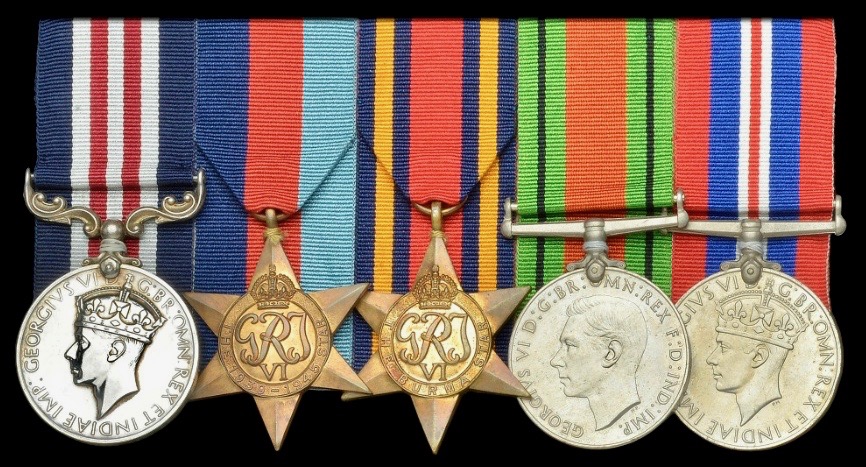
During the afternoon of April 11 the Japanese began shelling the defences, in preparation for yet another attack – during which they lost another 100 troops. More attacks followed on April 12 and 13, again repulsed with heavy losses. During the April 13 attack, Sergeant Harold Bottomley, with the Commando Platoon of the Lancashire Fusiliers’ 20 Column, won the MM. The Japanese knocked out three Bren weapon pits; Bottomley recovered the weapons, re-sited them, got them back into action and then went back for the wounded. On April 14, the Gurkhas and 45 Recce advanced out of the Block and killed over 300 Japanese for negligible loss. The intense fighting around White City continued. Calvert had a plan to sweep the Japanese attackers and push them against the Block perimeter, so they were caught on both sides. It was a close run thing, soon involving some 1,600 Chindits in a full-scale battle. They were hard pressed and the solution was a maximum strength air strike by 23 Mustangs, bombing the Japanese forming up areas only some 200 yards distant.
Morale remained solid within the Block; the men were convinced they could hold White City. Nightly supply drops brought in more equipment, food and ammunition. Some men were luckier than others. Lieutenant Peter Allnutt was with 12 NR’s 43 Column. Nine of his Company’s 12 Europeans became casualties at the Block. Two Platoon Commanders, George Manuel and Bill Briggs, were killed in action. Allnutt was the only officer to escape injury. Like everyone else, he hated the Japanese 6 in mortar, describing it as “a real horror … It fired a bomb that made a crater 12 ft across.” Whenever possible, the 25 pounders of S Troop engaged the heavy mortar teams.
Some Chindits were very exposed, being members of recce patrols. Corporal Tom Turvey was with the Leicester’s 71 Column Recce Platoon. He lived in a constant state of hunger and tension: “Everyone’s worst fear was a wound bad enough to cause you to be left behind. That was the nightmare. We all lived with that dread … the fear that the moment might come when you would be left.” It was not always possible to evacuate casualties by light aircraft and some badly wounded were shot, rather than be left for the Japanese.
They knew they could “bump” a Japanese patrol at any time and there were constant examples of Japanese cruelty. Turvey’s Recce Platoon entered a village visited by the enemy the day before: “They had offered the Headman a fag, then poured petrol over his head. We had an MO with us. He took one look at the Headman and said he would never survive. He gave the victim morphine. I suppose all the Japanese involved in that incident are dead now, but I would say that they are a bloody cruel race.”
White City’s garrison got a surprise on April 14, when two tanks emerged from Mawlu and were engaged by the two pounder guns. One was hit. They retreated and were not seen again.
A major assault on the eastern perimeter came at 04.00 on 15 April. The Japanese gained a foothold on one of White City’s hills by sheer weight of numbers. This hill was held by an officer and six men who refused to budge. A swift counter-attack threw out the Japanese; the enemy lost 150 killed. Fierce fighting continued the next day. Attacks on the perimeter were met with heavy defensive fire, attacks on the enemy’s rear and highly accurate “cab rank” strikes by 1st Air Commando’s Mustangs and bombing by B.25s. A Nigerian counter-attack ended the fighting.
The Chindits were doing severe damage to the 24th Independent Mixed Brigade and other units of the force of 10 Battalions assembled to destroy Special Force. According to Calvert, the 24th alone, with a strength of 5,495 men, suffered over 3,000 casualties at White City. The 3rd/114th, of 18th Division, also lost heavily on White City’s wired defences and in fighting around Mawlu. The 2nd/146th (56th Division) took one-third casualties during its attacks on Broadway. Around Indaw, 16 Brigade inflicted 250 casualties on the 2nd/29th (2nd Division) and the 2nd/51st (15th Division). The 1st/146th, confronting Morris Force on the Bhamo Road, took one-third casualties. Yet Chindit casualties within White City remained relatively small. Two weeks of heavy shelling, for example, killed 20 and wounded 40. The big attacks in mid-April were the enemy’s last throw against White City. The dead on the wire now posed a threat to the Block’s water supply.
Other Chindit operations included the attack by 14 Brigade elements on Bonchaung railway station and the Bonchaung Gorge bridges, south of Indaw, between Nankan and Wuntho. The forces involved included the Black Watch columns (42 and 73), the 7th Leicester’s 47 Column and the Bedfordshire and Hertfordshire’s 16 Column. They blew the main rail bridge and two other girder bridges. Their work was opposed by the Japanese, who lost over 40 killed.
This was dry country and the men suffered extreme thirst, to the point where many could no longer swallow food. Digging out dry chaungs produced some water, but not enough to fill hundreds of water bottles and meet the needs of the animals. Nevertheless, the attacks were pressed home. The York and Lancaster columns, 65 and 84, were involved. The Recce Officer of 65 Column was reduced to sucking dew from leaves.
The battle groups attacked the main bridge close to Bonchaung Station at 08.00 on 15 April. The York and Lancaster columns had a struggle. Their work of destruction attracted persistent interference from the enemy. Nevertheless, the main bridge was totally destroyed. The Japanese attempted to make them pay. The York and Lancaster’s bivouac for the “soft skin” elements was charged by the Japanese before the battle groups returned. There was some desperate fighting. The enemy was then hit in the rear by one of the returning battle groups. The Japanese dispersed as the Columns’ medical teams worked throughout the night, sterilising their surgical instruments in spirit and doing their best for the wounded with very little light. They buried their dead before moving off. The Battalion Commander, Lieutenant-Colonel Graves-Morris, sought a clearing big enough for light plane evacuation of his wounded. The best place was difficult to reach with stretcher cases and progress was slow. Many of the men had had no water for over a day. Their daily need was calculated at 12 pints. Relief came when they reached the Meza River. The bank was steep and muleteers and grooms ferried water up to the animals in canvas buckets. One man put a stop to this personal service after his charge had drained 15 buckets.
—ooo—
On April 9 Major Peter Cane’s 94 Column (4th/9th Gurkhas), with Morris Force, captured Myothit, 24 miles from Bhamo. They destroyed a river bridge, together with a ferry and a rice mill supplying the Japanese, before dispersing into the hills. The next day a Morris Force column, 40 (3rd/4th Gurkhas) set an ambush on the Bhamo-Lashio Road, destroying three vehicles and killing 30 Japanese.
During the April 11-16 period, 111 Brigade destroyed two supply dumps and killed 23 Japanese. The Cameronian’s 90 Column blocked a road and killed another 24. According to Slim, 111 Brigade’s activities west of Indaw and several other Chindit operations yielded only modest results. He wrote: “These operations did not, as I had hoped they would, seriously disorganise the Japanese communications with the Assam front. Their chief effect, as far as the battle there was concerned, was to delay for a couple of months two infantry and one artillery battalion … on their way to take part in the offensive against Imphal.” Given the difficulties of stopping the Japanese at Imphal/Kohima, this might be regarded as no mean achievement.
Now the King’s Own of 111 Brigade had a tough, 80-mile positioning trek before them, half the distance being along the Meza River. One man counted the number of times he crossed and re-crossed the river. He did it 70 times! Private Jim Unsworth was with 2 KORR’s 46 Column: “We were on our way to a Japanese supply dump on the other side of Indaw, south of what eventually became Blackpool Block, when we were ambushed. We had been marching hard to reach that dump and had only a 10-minute break around mid-afternoon. I was that tired I fell asleep, flat out on the ground. Shouting and firing woke me just a minute or two later. I stayed doggo as one of our Brens opened up. I had no idea what was happening. We took casualties and some of our heavy equipment, unloaded from the mules, was left behind.”
When the Column freed itself from this encounter, Lieutenant Littlewood was detailed to take a section of 10 men, return the two miles to the ambush site and retrieve the equipment, including the mortar base-plates. Jim Unsworth: “We headed back and found plenty of kit lying around. Then I saw a man slumped against a tree. I couldn’t recognise him, he was that white. A Japanese officer had struck him with a sword and he had been cut from shoulder to chest. There was no blood left in him. He was our Quartermaster. We couldn’t bury him.”
Two KORR Privates confirmed this account. Jack Redding was marching alongside a mule when the ambush was sprung. The mule was killed and he took shelter behind it, returning fire. He then saw the man killed by the swordsman, just feet in front of him. Very recently (March 2019), another account came to light, by 2 KORR Chindit Ernie Osborn, who was very close by and also witnessed this incident.
Littlewood, Unsworth and the rest of the section continued a few yards and found two dead Japanese close to the swordsman’s victim: “I said to Littlewood: ‘I thought the Japanese were supposed to be small’. These two were huge, over 6 ft tall. They were Imperial Guards, hit by a Bren burst.” Littlewood told him not to believe everything he was told. The two other witnesses confirmed that the attackers were Imperial Guards.
Unsworth had a personal victory when the Column reached the area of the depot. They called up a Mustang, to bomb a small force holding it. They attacked and the Japanese fled. Unsworth chased them and soon discovered he was one of a force of three in pursuit! Suddenly the thick bamboo opened out into a clearing filled with a line of brand new trucks, all loaded. Littlewood drew his bayonet and stabbed the first truck’s petrol tank. He then worked his way along the entire line. Unsworth set the pools of petrol ablaze. They left the clearing, reached the river and began to cross, coming under mortar fire. Then the main force came forward and destroyed the entire depot.
—ooo—
So far, the Chindits had done well, but they could do nothing to hold back the pending monsoon. The jungle airstrips could not be converted into all-weather airfields. There was a real worry that light plane evacuation of the wounded and sick would no longer be possible. This was an important factor influencing the move north. A link-up with American-led Chinese forces would be a lifeline for Chindit casualties. The onset of the monsoon was around four weeks away. Lentaigne’s priority was to retain a firm grip on the rail corridor, as Stilwell’s Chinese fought their way towards the main centre of Myitkyina. 111 Brigade now came to the fore. It would establish the new Block on the railway and road north of White City; 77 and 14 Brigades would act as a shield and mobile strike force.
White City had outrun its usefulness. Having failed to destroy the Block, the Japanese were now offloading trains and using motor transport to skirt round the Block, then load trains on the other side. Many of White City’s casualties were evacuated from Aberdeen and there were grim sights as the wounded arrived. Larry Gaines, of 6 NR’s 66 Column: “White City became known as the ‘Tobruk of Burma’. Soldiers who had been at both said the Burmese version was worse.”
—ooo—

